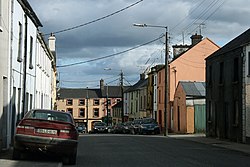Granard
| Granard | |
| County Longford | |
|---|---|
 Market Street | |
| Location | |
| Grid reference: | N324814 |
| Location: | 53°46’48"N, 7°30’0"W |
| Data | |
| Population: | 1,371 (2016) |
| Post town: | Granard |
| Postcode: | N39 |
| Local Government | |
| Council: | Longford |
Granard is a town in the north of County Longford that has a traceable history going back to AD 236. It is situated just south of the boundary between the watersheds of the Shannon and the Erne, at the point where the N55 national secondary road and the R194 regional road meet. Its population peaked at 2,534 in 1821, but as of 2016 was just over half that.
Contents
History
The town has been a centre of population since Celtic times, probably because of its elevated position offering a view over the surrounding countryside. It is mentioned in the ancient Irish epic, the Táin Bó Cuailgne, as being one of the places where Queen Medb and her army stopped on their journey to take the Donn Cuailnge (the Brown Bull of Cooley). The name of the town is itself so ancient as to be unclear even in Irish; the 11th-century writers of the Lebor na hUidre (containing the oldest written version of the Táin) refer to it by means of a gloss as "Gránairud Tethba tuaiscirt .i. Gránard indiu" ("Gránairud of northern Teathbha, i.e. Gránard of today"). According to the Tripartite Life of Saint Patrick, Patrick appointed Guasacht, a son of his former master Milchú, as first bishop of Granard, but the diocese did not survive as a separate entity. The surname Sheridan was first recorded in Granard in the 8th century.[1]
Granard is known for the motte built by Risteárd de Tiúit. It stands 543 ft above sea level, located at the head of the town. A statue of St Patrick was erected on the motte in 1932 to commemorate the 1500th anniversary of the coming of the saint to Ireland for the second time.[2] Due to the location between the three rivers and near Lough Sheelin, it is also a centre for trout and coarse fishing. The Gaynors (Mag Fhionbharra, from Fionnbharr Ó Géaradháin[3]) were once the Gaelic lords of Granard.
Granard was the location of an annual Harp festival from 1781 to 1785. This had been due to the financial support of James Dungan, an Irish merchant then residing in Copenhagen, and a native of Granard, who had heard of similar events being organised in Scotland. Many of the harpists who won prizes at these festivals, including Charles Fanning, Arthur O'Neill, and Rose Mooney went on to perform at the Belfast Harp Festival in July 1792. There has been a revival of the festival since 1981.
During the Irish War of Independence, on 31 October 1920 a police officer, District-Inspector Philip Kelleher was shot dead by two masked men in the bar of the Greville Arms Hotel, Granard. As a reprisal, a motor convoy of Crown forces entered the town four days later and systematically destroyed some of the main business premises of the town.[4]
Transport
Granard is within the catchment area for Edgeworthstown railway station. The station is about a fifteen-minute drive; there is no bus link.
There is one bus service a day to Monaghan (with onward connections to Belfast) and one service a day to Athlone (with onward connections to Galway). On Fridays there is a second service each way.[5] A local bus route between Cavan and Athboy (with onward connections to Trim and Dublin) serves Granard and operates four times a day each way, thrice each way on Saturdays and once each way on Sundays.[6]
A further local route operates from Granard to Longford via Ballinalee. There are three journeys each way daily (no Sunday service)[7]
Notable people
- Michael Gaffney, who founded the small town of Gaffney, South Carolina, in 1804, was born in Granard in 1775. His heritage is evident there today with streets named after his wife and children and one also named Granard Street.
- Kitty Kiernan (1892–1945) was born in Granard and later engaged to Irish revolutionary Michael Collins. After his death, she married army officer Felix Cronin.
- Eddie Macken, International show jumper, was born and lived in Granard.
- James O'Brien (1806–1882), High Court judge, was born in Granard.
- Brendan O'Reilly, television presenter, was born in Granard.
- Larry Cunningham (1938–2012), from nearby Clooneen, was an Irish country music singer, who accomplished a series of "firsts" during his career, including the first Irish showband artist to break into the British charts with "Tribute to Jim Reeves" in 1964. With his band, the Mighty Avons, he reached No 4 with "I Guess I'm Crazy" and No 1 with "Lovely Leitrim" in 1965.
- Thomas Henry "Tommy" Bond (April 2, 1856 – January 24, 1941) was a Major League Baseball player who was a pitcher and a right fielder a total of ten seasons. A native of Granard, Ireland, he is the first person born in Ireland to play Major League Baseball.
- Sr. Maeve Brady, is a member of the Sisters of Mercy congregation in Granard. She was awarded 'Longford person of the year' in 2009 and was a recent recipient of the Benemerenti Medal for service to the local community.
- Ann Lovett, a fifteen-year-old schoolgirl who died giving birth beside a grotto in 1984.
References
- ↑ Sheridan Clan (2007). "Clan History". WSI Ballsbridge. Archived from the original on 2010-06-05. https://web.archive.org/web/20100605070407/http://www.sheridanclan.ie/ClanHistory.aspx. Retrieved 2010-06-01.
- ↑ Lehane, Brendan (2001) The Companion Guide to Ireland; rev. ed. Woodbridge: Companion Guides ISBN 1 900639 34 3; pp. 101-02
- ↑ http://www.sloinne.ie/surname/en/gaynor/
- ↑ Anglo-Celt, Saturday, November 13, 1920
- ↑ http://buseireann.ie/pdf/1360942461-065.pdf
- ↑ http://buseireann.ie/pdf/1307702393-111.pdf
- ↑ http://www.journeyplanner.transportforireland.ie/nta/TTB/EFA03__00004495_TP.pdf